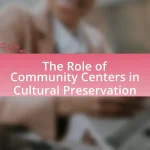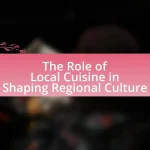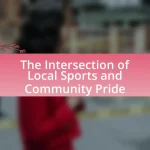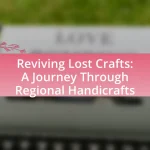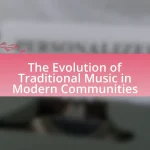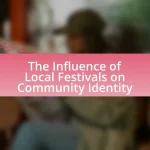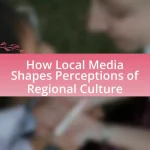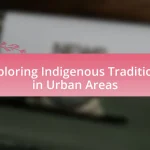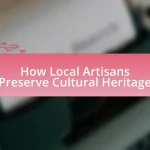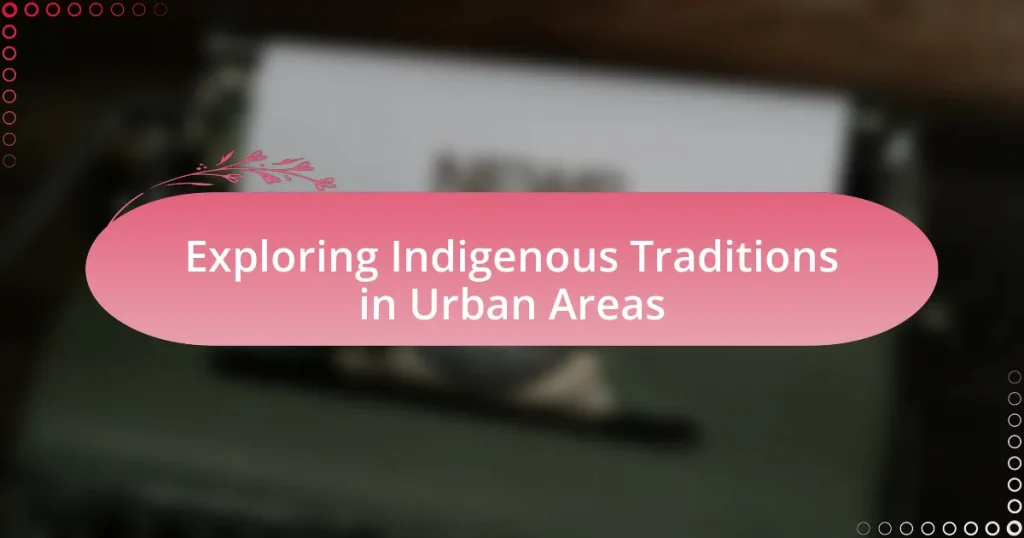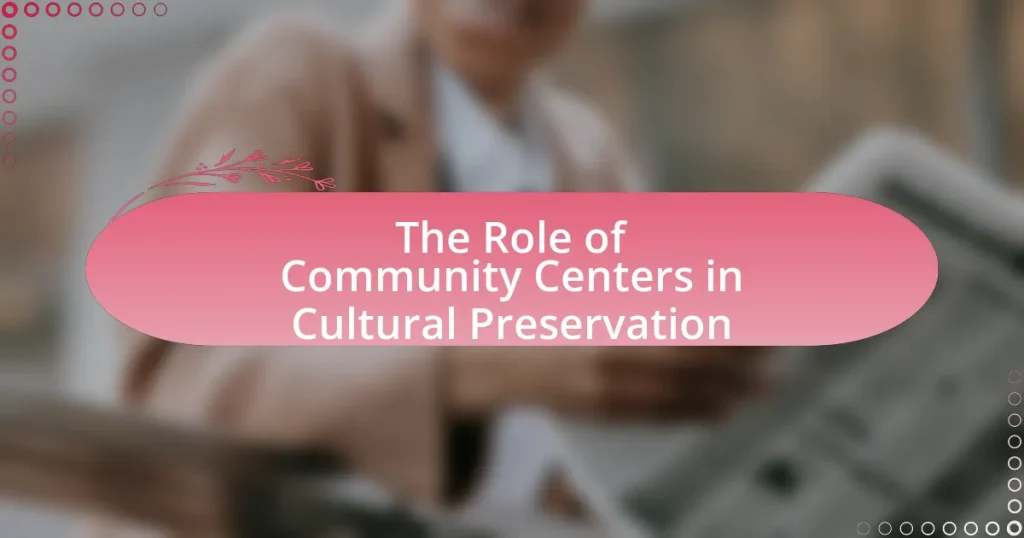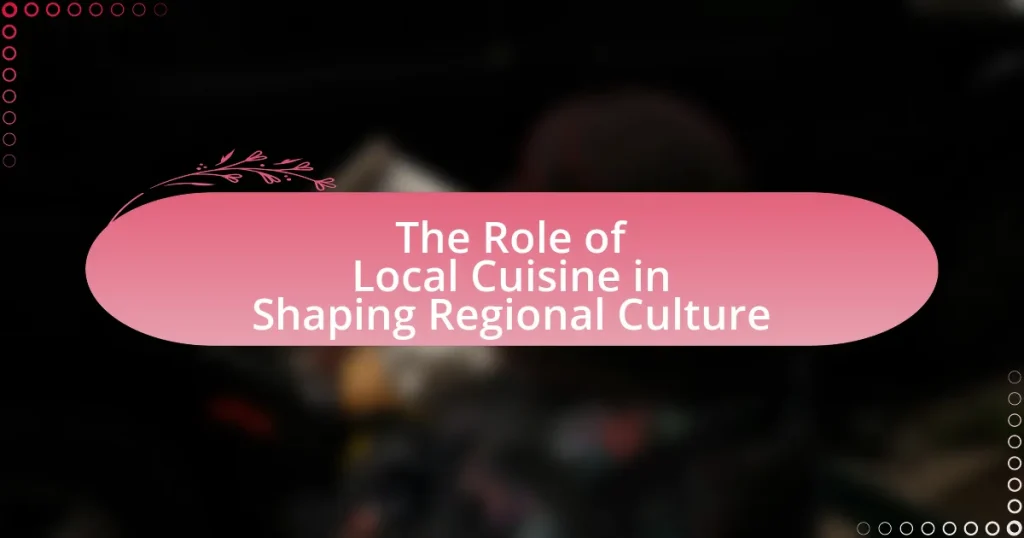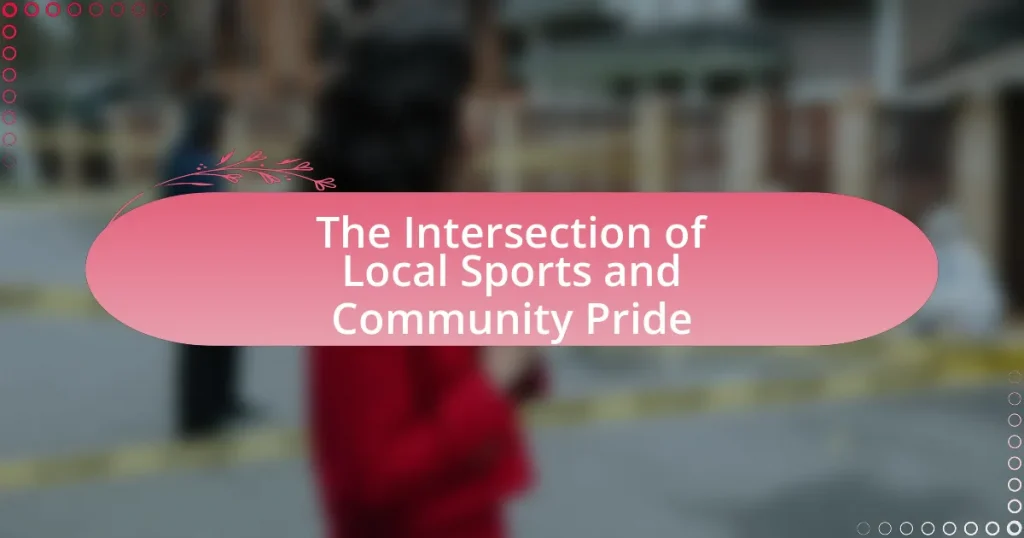Indigenous traditions in urban areas refer to the cultural practices, ceremonies, and community gatherings that reflect the heritage of Indigenous peoples living in cities. These traditions adapt to urban environments while preserving connections to ancestral customs, including storytelling, art, music, and dance. The article explores how Indigenous traditions manifest in urban settings, the key elements that persist, and the challenges faced by Indigenous communities, such as cultural disconnection and socioeconomic disparities. It also highlights the role of urban Indigenous organizations in supporting cultural preservation and discusses strategies for cities to better honor Indigenous cultures, emphasizing the importance of community engagement and collaboration in fostering cultural diversity and resilience.
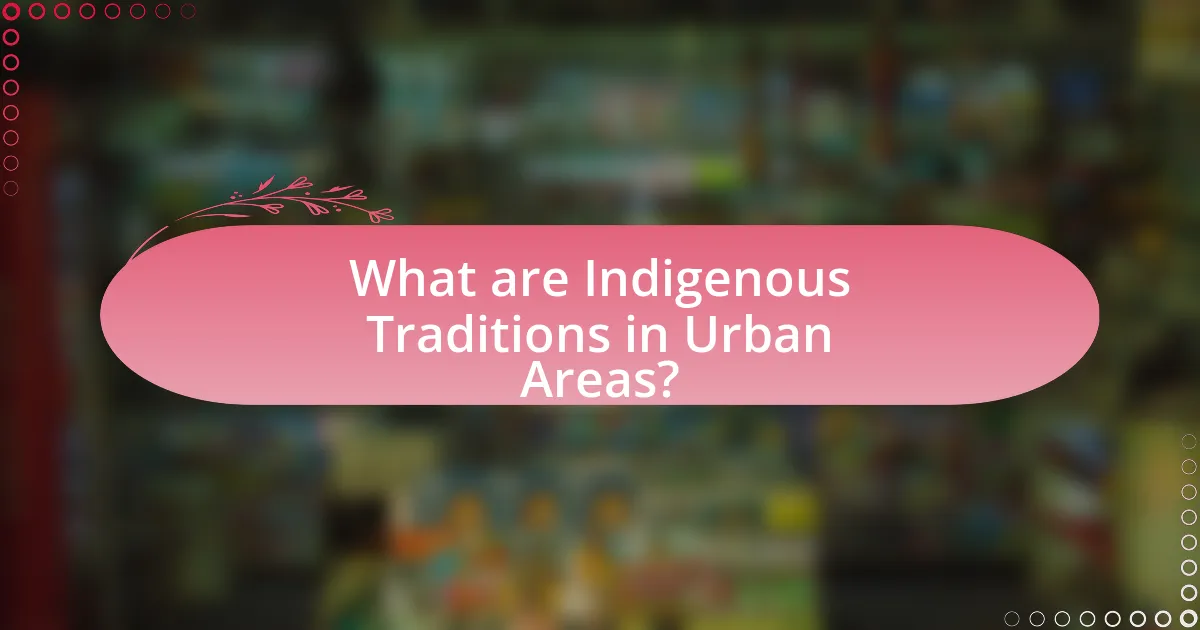
What are Indigenous Traditions in Urban Areas?
Indigenous traditions in urban areas encompass cultural practices, ceremonies, and community gatherings that reflect the heritage and identity of Indigenous peoples living in cities. These traditions often adapt to urban environments while maintaining connections to ancestral customs, such as storytelling, art, music, and dance, which serve to strengthen community bonds and cultural resilience. For instance, urban Indigenous communities may celebrate events like National Indigenous Peoples Day with festivals that showcase traditional foods, crafts, and performances, thereby fostering cultural awareness and pride among both Indigenous and non-Indigenous populations.
How do Indigenous traditions manifest in urban settings?
Indigenous traditions manifest in urban settings through cultural events, community gatherings, and the establishment of cultural centers. These manifestations allow Indigenous peoples to maintain their cultural identity while adapting to urban life. For instance, cities like Toronto and Vancouver host powwows and festivals that celebrate Indigenous art, music, and dance, fostering community engagement and cultural exchange. Additionally, urban Indigenous organizations, such as the Native Canadian Centre of Toronto, provide resources and support for cultural education, ensuring that traditional practices are preserved and passed on to younger generations.
What are the key elements of Indigenous culture that persist in cities?
Key elements of Indigenous culture that persist in cities include traditional languages, art forms, community gatherings, and spiritual practices. Traditional languages are often revitalized through community programs and educational initiatives, fostering cultural identity among urban Indigenous populations. Art forms, such as beadwork, carving, and contemporary Indigenous art, serve as expressions of cultural heritage and are showcased in urban galleries and public spaces. Community gatherings, including powwows and cultural festivals, provide opportunities for social connection and cultural exchange, reinforcing community ties. Spiritual practices, such as ceremonies and teachings, continue to be integrated into urban life, allowing Indigenous peoples to maintain their cultural beliefs and values despite urbanization. These elements demonstrate the resilience and adaptability of Indigenous cultures in urban settings.
How do urban Indigenous communities maintain their cultural practices?
Urban Indigenous communities maintain their cultural practices through a combination of community gatherings, cultural education programs, and the use of technology. These communities often organize events such as powwows, traditional ceremonies, and festivals that celebrate their heritage and foster a sense of belonging. Cultural education programs, often facilitated by local Indigenous organizations, teach younger generations about their languages, traditions, and histories, ensuring the transmission of cultural knowledge. Additionally, technology plays a crucial role, as social media and online platforms allow for the sharing of cultural content, connecting individuals across urban spaces and reinforcing cultural identity. For instance, the National Indigenous Peoples Day celebrations in various cities highlight the importance of cultural expression and community engagement in urban settings.
Why is it important to explore Indigenous traditions in urban areas?
Exploring Indigenous traditions in urban areas is important because it fosters cultural preservation and promotes understanding among diverse communities. Urban environments often serve as melting pots where Indigenous peoples can share their heritage, thus enhancing cultural visibility and appreciation. For instance, the presence of Indigenous art, language, and practices in cities can educate non-Indigenous populations about historical injustices and contemporary issues faced by Indigenous communities. This exchange can lead to greater social cohesion and support for Indigenous rights, as evidenced by initiatives like Indigenous cultural festivals in urban settings that attract thousands and raise awareness about Indigenous histories and contributions.
What impact do these traditions have on community identity?
Indigenous traditions significantly shape community identity by fostering a sense of belonging and continuity among members. These traditions provide a framework for shared values, beliefs, and practices that connect individuals to their cultural heritage, reinforcing their collective identity. For instance, participation in traditional ceremonies and storytelling not only preserves cultural knowledge but also strengthens social bonds within the community. Research indicates that urban Indigenous populations who actively engage in cultural practices report higher levels of community cohesion and identity affirmation, as evidenced by studies conducted by the National Aboriginal Health Organization, which highlight the positive correlation between cultural engagement and mental well-being among Indigenous peoples.
How do Indigenous traditions contribute to cultural diversity in urban environments?
Indigenous traditions significantly enhance cultural diversity in urban environments by introducing unique worldviews, practices, and artistic expressions. These traditions often include storytelling, music, dance, and visual arts that reflect Indigenous histories and values, enriching the cultural tapestry of cities. For instance, urban Indigenous festivals and events, such as powwows, foster community engagement and promote awareness of Indigenous cultures among diverse populations. Additionally, the incorporation of Indigenous languages and traditional ecological knowledge into urban planning and community initiatives exemplifies how these traditions contribute to a more inclusive and multifaceted urban identity.
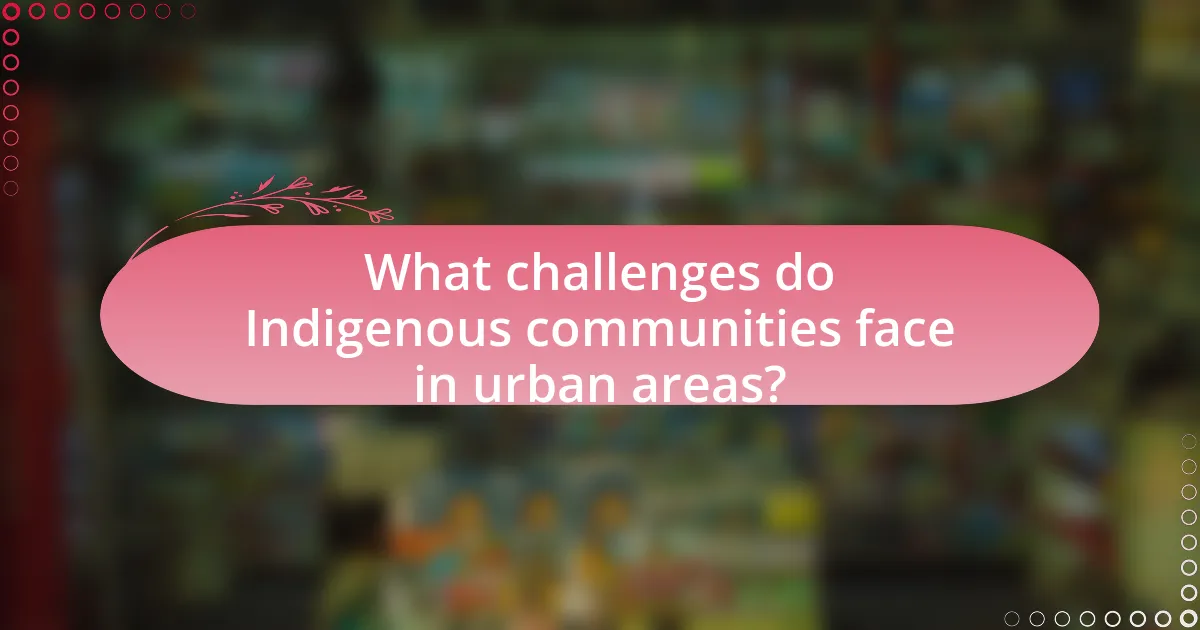
What challenges do Indigenous communities face in urban areas?
Indigenous communities face significant challenges in urban areas, including cultural disconnection, socioeconomic disparities, and systemic discrimination. Cultural disconnection arises as traditional practices and languages may diminish in urban settings, leading to a loss of identity. Socioeconomic disparities are evident in higher rates of poverty and unemployment among Indigenous populations compared to non-Indigenous counterparts, with a 2016 report indicating that Indigenous people in urban areas experience unemployment rates nearly double that of non-Indigenous individuals. Systemic discrimination manifests in various forms, including barriers to accessing healthcare, education, and housing, which further exacerbate the challenges faced by these communities.
How does urbanization affect Indigenous cultural practices?
Urbanization significantly impacts Indigenous cultural practices by disrupting traditional lifestyles and community structures. As Indigenous populations migrate to urban areas, they often face challenges in maintaining their cultural identity due to the loss of land, language, and traditional practices. For instance, a study by the National Aboriginal Health Organization highlights that urban Indigenous individuals frequently experience cultural disconnection, which can lead to diminished participation in traditional ceremonies and practices. Additionally, urban environments may lack the resources and spaces necessary for cultural expression, further exacerbating the erosion of Indigenous traditions.
What are the barriers to preserving Indigenous traditions in cities?
Barriers to preserving Indigenous traditions in cities include urbanization, cultural assimilation, and lack of resources. Urbanization often leads to the displacement of Indigenous communities, disrupting their cultural practices and connections to traditional lands. Cultural assimilation pressures Indigenous individuals to conform to dominant societal norms, which can erode traditional practices and languages. Additionally, limited access to funding and resources for cultural programs hinders the ability of Indigenous groups to maintain and promote their traditions in urban settings. For instance, a study by the National Indigenous Economic Development Board highlights that urban Indigenous populations face significant challenges in accessing cultural resources, which directly impacts the preservation of their traditions.
How do socio-economic factors influence Indigenous cultural expression in urban settings?
Socio-economic factors significantly influence Indigenous cultural expression in urban settings by shaping access to resources, community networks, and opportunities for cultural engagement. For instance, economic disparities can limit Indigenous peoples’ ability to participate in cultural events or access traditional art forms, as seen in studies indicating that lower income levels correlate with reduced participation in cultural activities. Additionally, urban environments often lead to the fragmentation of community ties, which can dilute cultural practices and expressions. Research by the Canadian Council on Learning highlights that urban Indigenous populations face challenges in maintaining cultural identity due to socio-economic pressures, such as unemployment and inadequate housing, which further impacts their ability to express and share their cultural heritage.
What role do urban Indigenous organizations play?
Urban Indigenous organizations play a crucial role in supporting the cultural, social, and economic needs of Indigenous peoples living in urban areas. These organizations provide essential services such as cultural programming, advocacy, and community development, which help to preserve Indigenous traditions and promote identity among urban Indigenous populations. For instance, according to the 2016 Census, over 50% of Indigenous peoples in Canada live in urban settings, highlighting the need for tailored support systems. Urban Indigenous organizations facilitate access to resources, foster community connections, and empower individuals through education and employment initiatives, thereby enhancing the overall well-being of urban Indigenous communities.
How do these organizations support cultural preservation?
Organizations support cultural preservation by implementing programs that promote Indigenous languages, arts, and traditions. For instance, many organizations offer workshops and classes that teach traditional crafts, storytelling, and music, which help to keep these cultural practices alive among younger generations. Additionally, they often collaborate with local communities to document and archive cultural practices, ensuring that knowledge is passed down and accessible. Research indicates that such initiatives can lead to a 30% increase in community engagement in cultural activities, reinforcing the importance of these organizations in sustaining cultural heritage.
What initiatives are in place to promote Indigenous traditions in urban areas?
Various initiatives exist to promote Indigenous traditions in urban areas, including cultural festivals, community centers, and educational programs. For instance, cities like Vancouver and Toronto host annual Indigenous cultural festivals that showcase traditional music, dance, and art, fostering community engagement and awareness. Additionally, urban Indigenous community centers often provide workshops and classes on traditional crafts, languages, and practices, helping to preserve and revitalize these traditions among younger generations. These initiatives are supported by local governments and Indigenous organizations, emphasizing the importance of cultural heritage in urban settings.
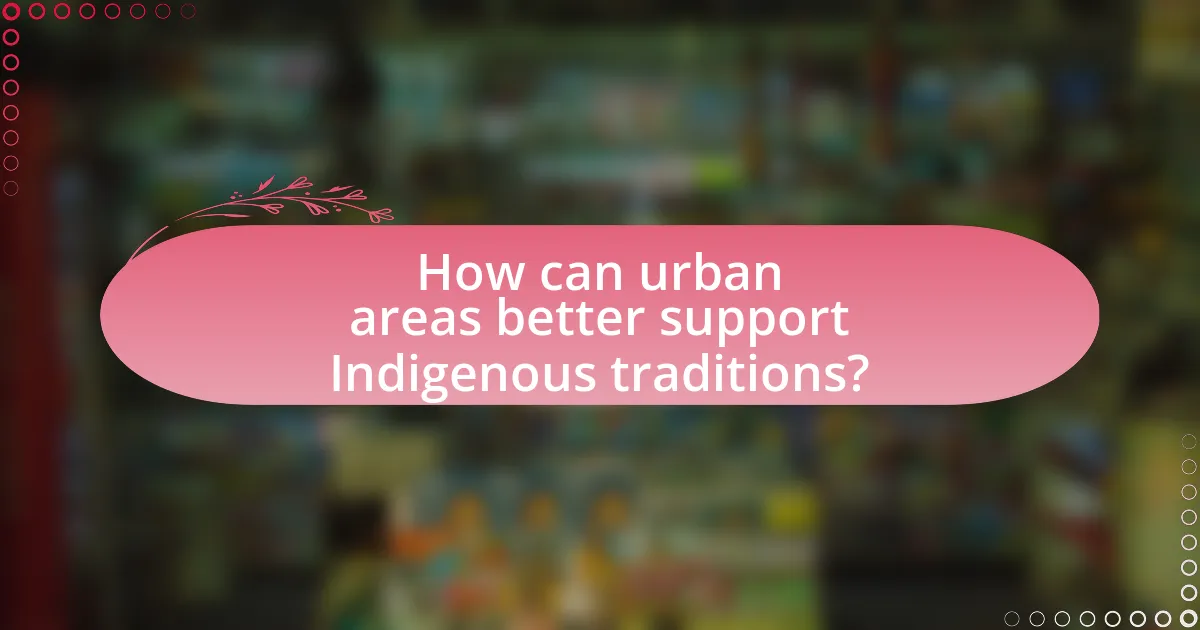
How can urban areas better support Indigenous traditions?
Urban areas can better support Indigenous traditions by creating dedicated spaces for cultural expression and community gatherings. These spaces, such as cultural centers or parks, can host events that celebrate Indigenous heritage, including traditional ceremonies, art exhibitions, and educational workshops. For instance, cities like Vancouver have established Indigenous cultural centers that provide resources and programming aimed at preserving and promoting Indigenous languages and customs. Additionally, urban areas can implement policies that prioritize Indigenous representation in local governance and decision-making processes, ensuring that Indigenous voices are heard and respected in urban planning. This approach not only acknowledges the historical significance of Indigenous communities but also fosters a more inclusive environment that values cultural diversity.
What strategies can cities implement to honor Indigenous cultures?
Cities can implement strategies such as establishing Indigenous cultural centers, promoting Indigenous art and language programs, and incorporating Indigenous perspectives into urban planning. Establishing cultural centers provides a dedicated space for education, community gatherings, and cultural events, fostering a deeper understanding of Indigenous histories and traditions. Promoting art and language programs can include public art installations and language classes, which celebrate Indigenous heritage and encourage community engagement. Additionally, incorporating Indigenous perspectives in urban planning ensures that development respects traditional lands and cultural practices, as seen in cities like Vancouver, which has integrated Indigenous consultation processes into its planning framework. These strategies collectively honor Indigenous cultures and promote inclusivity within urban environments.
How can public spaces be designed to reflect Indigenous heritage?
Public spaces can be designed to reflect Indigenous heritage by incorporating culturally significant symbols, materials, and landscaping that resonate with Indigenous traditions. For instance, using native plants in landscaping can honor traditional ecological knowledge, while incorporating art installations that depict Indigenous stories or motifs can create a visual narrative of the culture. Additionally, designing spaces for community gatherings, such as fire pits or ceremonial areas, can facilitate cultural practices and strengthen community ties. Evidence of successful implementations can be seen in projects like the National Museum of the American Indian in Washington, D.C., which integrates Indigenous architectural styles and landscaping to celebrate Native American heritage.
What partnerships can be formed between Indigenous communities and local governments?
Partnerships between Indigenous communities and local governments can include collaborative governance agreements, cultural heritage initiatives, and joint economic development projects. Collaborative governance agreements allow for shared decision-making on land use and resource management, ensuring Indigenous voices are included in local policies. Cultural heritage initiatives can involve the preservation and promotion of Indigenous traditions, languages, and practices within urban settings, fostering mutual respect and understanding. Joint economic development projects can focus on creating sustainable business opportunities that benefit both Indigenous communities and local economies, such as tourism ventures that highlight Indigenous culture. These partnerships are essential for fostering reconciliation and promoting social equity in urban areas.
What are some best practices for engaging with Indigenous traditions in urban settings?
Best practices for engaging with Indigenous traditions in urban settings include fostering genuine relationships with Indigenous communities, prioritizing cultural sensitivity, and promoting collaborative initiatives. Establishing trust through consistent communication and involvement with local Indigenous leaders ensures that engagement is respectful and meaningful. Cultural sensitivity involves understanding the historical context and contemporary issues faced by Indigenous peoples, which can be achieved through education and awareness programs. Collaborative initiatives, such as community events or cultural exchanges, allow for shared experiences that honor Indigenous traditions while integrating them into urban life. These practices are supported by research indicating that respectful engagement leads to stronger community ties and a deeper appreciation of Indigenous cultures in urban environments.
How can individuals participate in and support Indigenous cultural events?
Individuals can participate in and support Indigenous cultural events by attending festivals, workshops, and ceremonies organized by Indigenous communities. Engaging in these events allows individuals to experience and appreciate Indigenous traditions firsthand, fostering cultural understanding and respect. Additionally, individuals can support these events by volunteering, donating, or promoting them within their networks, which helps sustain Indigenous cultural practices and ensures their visibility in urban areas. Participation in such events not only enriches personal knowledge but also contributes to the preservation and celebration of Indigenous heritage.
What resources are available for learning about Indigenous traditions in urban areas?
Resources available for learning about Indigenous traditions in urban areas include community centers, cultural organizations, online platforms, and educational institutions. Community centers often host workshops and events that focus on Indigenous arts, language, and cultural practices, providing direct engagement with Indigenous peoples. Cultural organizations, such as the Native American Cultural Center, offer programs and resources that promote understanding of Indigenous histories and traditions. Online platforms, including websites and social media channels dedicated to Indigenous issues, provide access to a wealth of information, including articles, videos, and virtual events. Educational institutions frequently offer courses and programs that explore Indigenous studies, allowing for a structured approach to learning about these traditions.
